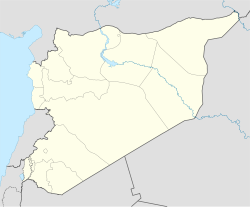- Al-Sukhnah
-
al-Sukhnah
السخنةLocation in Syria Coordinates: 34°53′12.5″N 38°52′19.5″E / 34.886806°N 38.872083°ECoordinates: 34°53′12.5″N 38°52′19.5″E / 34.886806°N 38.872083°E Country  Syria
SyriaGovernorate Homs Governorate District Palmyra District Elevation 1,512 ft (460 m) Population (1989) – Total 15,000 (together with al-Kawm and Tayyibah) Al-Sukhnah (Arabic: السخنة, translation: "the Hot [Springs]") is a town in eastern Syria under the administration of the Homs Governorate, located between Palmyra and ar-Raqqah. Together with its satellite villages of al-Kawm and Tayyibah, al-Sukhnah had a population of 15,000 in 1989. It has attracted hundreds of residents from nearby villages in the past century.[1]
Contents
History
In 1225, al-Sukhnah was described by Arab geographer Yaqut al-Hamawi as "a small town in the Syrian Desert, lying between Tadmur and Urd and Arak. Beside its spring are palm trees. It is on the road of one going to Damascus from ar-Raqqah, and you come to it before reaching Arak." In the mid-14th century, Ibn Batuta wrote that al-Sukhnah was "a pretty town", with a mostly Christian population. He noted that the al-Sukhnah received its name from the heat of its water, and that there were bathhouses in the town.[2]
Throughout the 17th and 18th centuries, al-Sukhnah served as an important trade center in the Syrian Desert among the inhabitants of nearby villages and various Bedouin tribes. By the mid-19th-century, however, its role decreased with the rise of Deir ez-Zor. In the 20th-century until the present day, Sukhnah continues to function as a trading center between its residents and the tribes in its vicinity, such as the 'Umur and the Sba'a.[1]
Economy
The residents of Sukhnah were linked to these different tribes through various hierarchical economic ties. They paid the levy on the their grain harvest to the Sba'a, who in return protected their trade. They also consigated their sheep flocks to the 'Umur and the Hadidiyin. To all these tribes, al-Sukhnah's residents supplied grain, cloth, clothing, and various household items and foodstuffs, while purchasing from them pastoral products for resale to Syria's large cities.[1]
Bibliography
- Mundy, Martha; Musallam, Basim (2000), Transformation of Nomadic Society in the Arab East, Cambridge University Press, ISBN 0521770572, 9780521770576, http://books.google.com/?id=iwxeHaKUGFMC&pg=PA132&dq=Sukhna+Syria.
- le Strange, Guy (1890), Palestine Under the Moslems: A Description of Syria and the Holy Land from A.D. 650 to 1500, Committee of the Palestine Exploration Fund, http://books.google.com/?id=ENANAAAAIAAJ&pg=PA493&dq=Lajjun+Guy+le+Strange.
References
Homs Governorate Cities

Towns and villages al-Akkari · Al-Hwash · Arak · Ayfir · Bir Basiri · Dar al-Abid al-Sud · Deir Ba'albah · Fairouzeh · Furqlus · al-Ghantoo · al-Ghuntir · al-Halbah · Hisyah · Hulayhila · Huwaysis · al-Jabbat · Jibab Hamad · Jubb al-Jarrah · Jubb al-Shami · al-Kawm · Khirbet Duwayzin · Mahin · Marmarita · Mihassah · Mukharram al-Fawqani · al-Qadr · al-Qaryatayn · Qatna · Ribla · Sab Abar · Sadad · Sayyadah · Shin · Shinshar · al-Sukhnah · Talbisa · Tall Daww · al-Tanf · Tayyibah · Tiyas · Zaydal · ZweitinaCategories:- Populated places in Homs Governorate
Wikimedia Foundation. 2010.

